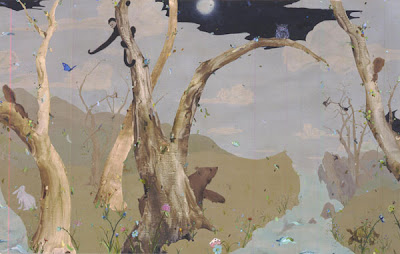Oil on Canvas 300 x 170cm
8 April 2008

This particular painting was hung in the White Cube gallery space and I have selected it primarily because of the technique and the use of a house as a motif. I am particularly curious to know if this work has been re-titled to help associations with the exhibition. I find it hard to believe that he had the house of Usher in mind when he painted this particular dripping house back in 1997. Is it significant that he has called the work untitled only to give meaning back with a subtitle?
A single storey house set against a graduated red-grey backdrop. There are tall trees looming behind the house and paint from the roof and eaves drips upwards. This disconcerting trick makes suggests a "model building" that has been dropped into a fish tank whilst the paint is still wet.
It is a relatively large canvas that gives plenty of room for his more expressive passages to assert themselves. The composition is thirds but unusually (and probably this contradiction is the key unheimlich device) the format is vertical rather than horizontal, with the subject confined to the lower third. Having the low horizon (something he shares with Nigel Cooke) is unsettling as we look at the subject. I suspect the source for the image is from a found photograph of the property, with his own invention for the background. The tree motifs crop up in all his work based on this subject.
The ground is blended thick opaque paint. I would guess the two colours are applied horizontally in bands with the proportion of the second colour in the mix increasing as he progresses down the canvas. The bands are then blended together horizontally with a dry wide bristle brush. I have done this in the past with a conventional house painting brush. A fairly rich medium ensures the paint stays open long enough for the blending, even on a large canvas and also helps heal the brush marks. I used a dry 4” badger blender over the top to remove all brush marks and give a very slick surface.
The more expressive background elements are painted over this blended ground once it is dry. He uses different brush techniques for each type of tree/shrub. All looks very controlled and ordered. The house itself is rendered in opaque white paint, thick enough to stand proud of the surface. It is probably painted upside down to allow the drips and runs to become a chance element within the work. Here it is predominantly a grey from the roof which runs – but in other works I have seen the white drips more prominently. Foreground is a narrow sandy coloured band with splodges of paint for bushes/grass to help create depth.
The painting has a stillness and a feel of the architectural uncanny which I like, but despite the associations of the title, I don’t find the image particularly melancholic.
©blackdog 2009



























